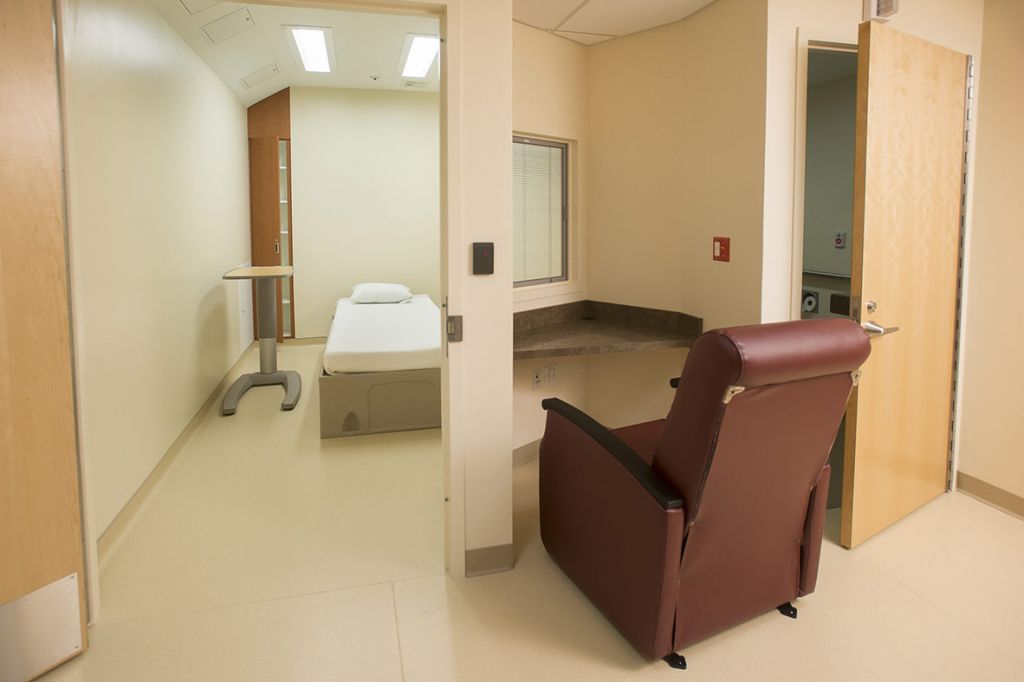September 26, 2016
September 26, 2016
For immediate release: Dec. 17, 2015
In late November, a new mental health area within the Cooley Dickinson Hospital Emergency Department opened to patients who are experiencing psychiatric emergencies.
Safe, Dignified Care

The four-bed “pod” is a calmer, safer, more controlled environment where a subset of Cooley Dickinson’s Emergency Department patients – roughly 10 percent of the people who visit the ER each day – can be evaluated and receive treatment.
Previously, people with psychiatric complaints would go to the general Emergency Department. Due to the shortage of psychiatric beds in Massachusetts, patients – some of whom could be anxious and agitated – waited many hours, sometimes days, in Emergency Department hallways or rooms. They awaited admission to Cooley Dickinson’s inpatient behavioral health unit or transfer to another facility.
“Within the new behavioral health pods, four private, single rooms comprise a dedicated mental health area,” says Ryn Gluckman, RN, nurse manager of the Emergency Department.
“The new design allows for an improved delivery of care that focuses on patient safety and privacy.” Gluckman adds that safe rooms mean beds are secured to the floor, TVs are in cabinets with shatterproof glass, and nurses and technicians observe patients via monitors.
Patients who are eligible for the pod have been evaluated by an emergency department physician; assignments to the pod depend on an individual’s mental health symptoms. Symptoms must not be related to a medical problem nor do they require medical monitoring, such as heart monitoring.
Tools for Therapeutic Treatment
Within the safe space of the behavioral health pod, patients have access to therapeutic tools such as yoga mats, board games, puzzles, and weighted blankets.
“These therapeutic tools offer self-nurturing choices for prevention and crisis de-escalation,” said Loretta-Jo Kapinos, RN, one of the nurse managers who was instrumental in developing the protocols for the pod.
“Our goal is to provide more focused care tailored to the unique needs of people with psychiatric issues. We hope to facilitate admission to Cooley Dickinson’s inpatient behavioral health unit, transfer to another facility, or discharging the patient to home.”
Pod Staffing
The staff who work in the pods include emergency medicine-trained registered nurses and behavioral health technicians. Staff have been trained in trauma-informed care, an approach that realizes the widespread impact of trauma and understands the potential paths for recovery; recognizes the signs and symptoms of trauma in clients, families, staff; responds by fully integrating knowledge about trauma into policies, procedures, and practices, and seeks to resist re-traumatization. In addition, staff cross-train and work on the inpatient behavioral health unit at Cooley Dickinson Hospital.
Fewer Beds for Psychiatric Patients
Along with Emergency Departments across the state, Cooley Dickinson has seen an increase in people who present with mental health emergencies. According to a 2013 Centers for Disease Control and Prevention report, the number of emergency department visits associated with mental health disorders is increasing in the United States.
They report that “patients with mental health disorders (MHDs) use the emergency department (ED) for acute psychiatric emergencies, for injuries and illnesses complicated by or related to their MHD, or when psychiatric or primary-care options are inaccessible or unavailable. EDs are an important part of the overall system providing health care for patients with MHDs.”


I am a clinical social worker and also have an extended family member with mental illness. It’s fantastic to learn of this dedicated space at Cooley Dickinson, for people suffering acute MH symptoms. The general ED is so anti-therapeutic for people experiencing suicidal urges, intense anxiety, or mania, psychosis, and other symptoms. Thank you so much. California is the only other place I’m aware of which has been running an “experimental program,” of 24/7 mental health ED’s, but only for Medicaid patients and only one each in 4 of their biggest cities.